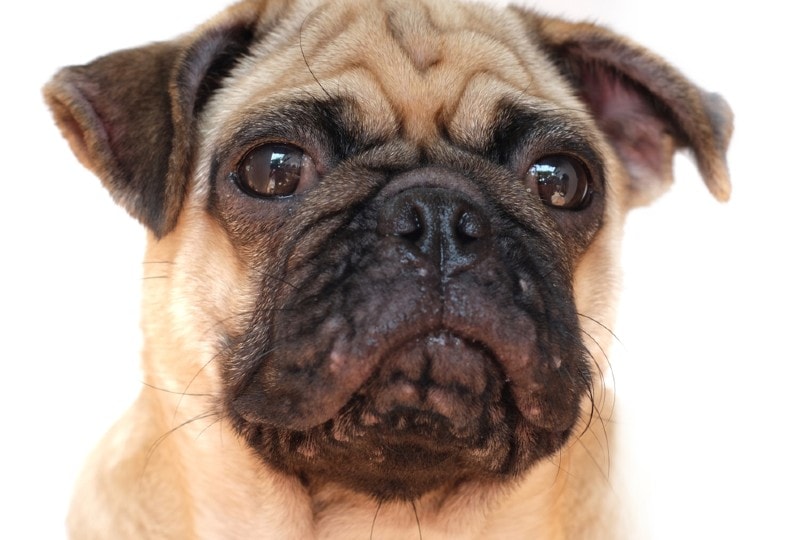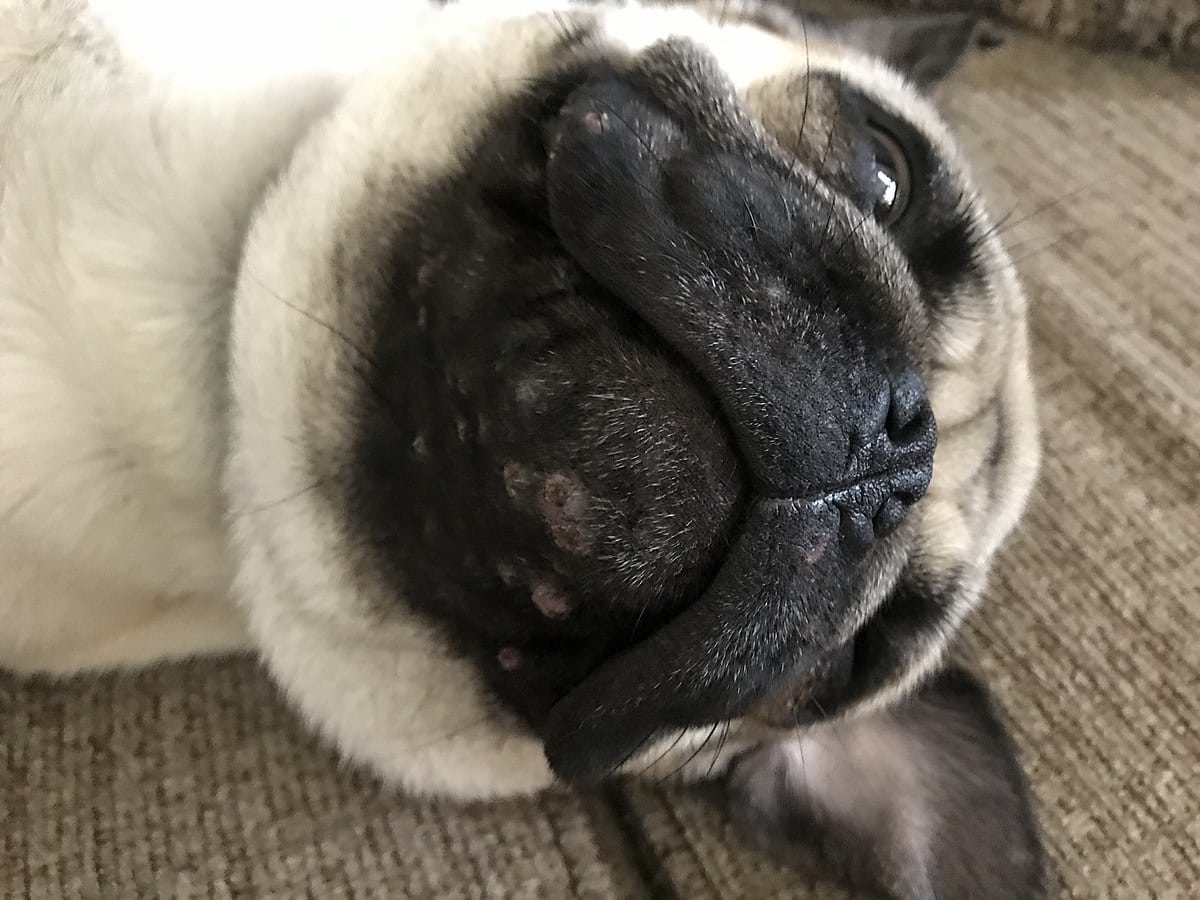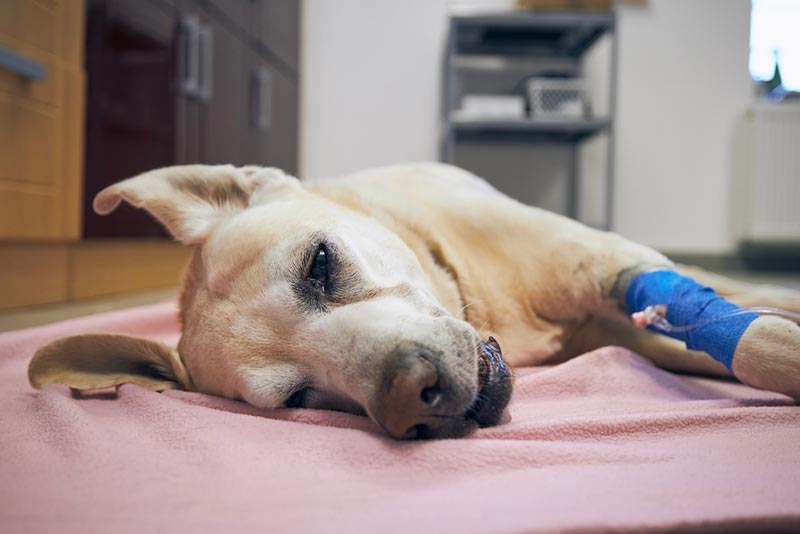Canine Acne: Causes, Symptoms and Care (Vet Answer)
Updated on

Acne can be annoying and frustrating, no matter which species it affects. And, just like humans, dogs are also prone to acne, with many similarities occurring between the two species—e.g., often found on the face or head, stubborn to treat in some cases, more common in younger individuals, and nothing to do with the food they eat! Acne defines a condition where the skin—in particular, the hair follicles—become inflamed. Canine acne, in its early stages, it can simply have the appearance of red bumps on your dog’s skin and may be difficult to notice. As it progresses, larger areas may become involved, and bacterial infections may also occur, making the entire process far more noticeable with typical “white heads”, or skin pustules arising. In severe cases, or if left untreated, acne can even progress to facial swelling and permanent scarring. At this point, the condition may also become painful for your pup!
The good news is that, in many cases, canine acne is quite treatable. Further, it is almost never life-threatening. And young pups will often grow out of the acne as they get older (much like people!). Read on to learn more about canine acne —including the causes, what to look for, and how to care for your pup with a case of the pustules!
What Causes Acne in Dogs?
The truth is, no single cause of canine acne has been identified—similar to acne in most other species. As frustrating as this can be, some theories do exist as to how acne in dogs occurs. Some cases are thought to be initiated when some type of trauma occurs to the skin of the face. This trauma, in turn, leads to irritation and inflammation of local hair follicles. This causes the follicles to become blocked, sometimes leading to infection and/or rupture, and the typical signs of acne that we think of: redness, irritation, pustules, bleeding, and scabs.
In other cases of acne, trauma seems to be unrelated to the development of the condition. Dogs, particularly young pups, can develop a form of acne called “puppy pyoderma”, that often resolves as they get older. Some cases of acne may be related to skin mites, if the parasites infect the hair follicles and cause an inflammatory reaction. Other cases may be caused by allergies to items, such as food. And yet, other causes may simply never be identified. Certain short-haired dog breeds may also be more predisposed to developing the issue, including Boxers, Dobermans, Great Danes, Rottweilers, and German Short-Haired Pointers.

Where Are the Symptoms of Acne in Dogs?
Acne symptoms are basically what you’d expect, whether canine or human—red or white bumps on the skin. In humans, we’d likely call them pimples. In medical terms, they are more appropriately called pustules.
However, as acne progresses, it can become far worse. Infection of the hair follicles can lead to draining tracts, ingrown hairs, pain, and permanent deformation of the affected skin. In these later stages, the condition is often considered painful and itching, causing facial swelling, in which pawing or rubbing of the affected area may occur.
Most importantly, dogs with acne generally show no signs of feeling unwell; they simply have acne. That means that signs of weight loss, changes in appetite, lethargy, or other typical signs of illness should not be seen in dogs with acne. And if they are, you should definitely reach out to your vet. Other good news is that acne is almost never an emergency condition, though it is always advisable to contact your vet for guidance about how to proceed once it is found.
How is Canine Acne Diagnosed?
In many cases of acne, the diagnosis is often straightforward and based purely on visual appearance. Both the characteristic changes in the skin, as well as the location, are often enough to make a convincing diagnosis of acne. However, if the diagnosis is in question, other testing can sometimes be required. This may be scrapes or culture of the skin to look for parasites or infections (fungal, bacterial), or biopsies of affected areas, to ensure that other more sinister processes (such as cancer) are not at play.
What Are the Treatment Options for Dogs with Acne?
Treatment options are often fairly straightforward. Sometimes your vet may simply advise you to monitor your pup, if the acne is not severe. This is often the case in younger pups as well. In more severe cases, however, sometimes other treatments are needed. This may include antibiotics, based on skin cultures, or anti-inflammatory medications. Treatments may be topical, meaning they are applied directly to the affected skin, or oral, meaning vet-prescribed liquids or tablets to be ingested.
Frequently Asked Questions (FAQs)
Is acne in dogs contagious?
The good news is that acne isn’t contagious from one dog to another—at least not that anyone knows of. Therefore, no reason exists to isolate dogs with acne from others in the house.
What can look similar to acne in dogs?
Acne in dogs has a pretty standard appearance, and therefore, it’s generally tough to mistake for other issues. If ever in doubt, take a photo to show your vet, and seek their guidance.
Can dog acne be prevented?
Because there is no single known cause for dog acne, prevention isn’t so straightforward. Some theories suggest that acne may form in some individuals that have skin imbalances. So, adding fatty acids or other skin supplements to a dog’s diet may be an option. Speak with your vet to find out what may help in your particular pup’s circumstances.
Similarly, if food allergies are suspected to be related to your dog’s condition, specific foods may be avoided, or even prescription diets that contain no allergens may be used. Again, speak to your dog’s vet to see if these are recommended in your dog’s particular circumstances.
Conclusion
Acne in dogs can be frustrating for it’s visual appearance, or for the difficulty in treating some dogs with the condition. However, it is one of the least serious skin illnesses experienced in dogs, and therefore, dogs with acne are generally fine in the long run.















